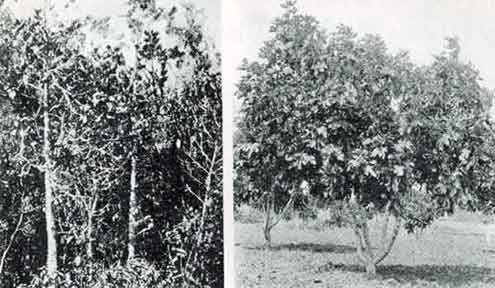These Ten Trees Are The Most Important In All The World
By HENRY CLEPPER
Nature Magazine, September 1937
Page 1 | Page 2
The author submits the following list as the ten most important trees in the world:
1. The date palm
2. The coconut palm
3. The almond tree
4. The apple tree
5. The fig tree
6. The mulberry tree
7. The olive tree
8. The lemon tree
9. The cinchona tree
10. The rubber tree
Do you agree?

THE CINCHONA AND THE FIG TREE
Naming the ten most important trees in the world is similar to naming the ten best books or the ten greatest men. It is apt to arouse a great deal of controversy. Foresters, botanists and naturalists generally cannot be expected to accept any such classification of trees, but the writer, after some years of study, herewith submits his list of the ten most important for the reader's agreement or violent disagreement, as the case may be.
First, however, a word as to prerequisites for a place on the list. To win a place, a species had to fall within several definite categories of usefulness. To begin with, it had to be of great importance to man. Second, it had to be in extensive use for a long period of time; for at least one thousand years. (One exception to this rule was allowed, as will be noted later.) Third, it had to be a species that, if suddenly taken from the face of the earth, could not readily be replaced by any other.
Such records of antiquity as have come down to us reveal that many species of trees have been cultivated by man for food and other purposes since before the dawn of human history. Consequently, among the most useful are those that provide food, particularly food in the form of fruit.
Unquestionably then, the foremost families of trees are the palms. And first in importance, and number one on the list, because of its long use by millions of people throughout the world, is the date palm, Phoenix dactylifera. This tree is known to have been in cultivation for more than 4000 years. It supplies the date of commerce, oil, wood, and fiber. The palm mentioned in the Bible for centuries has been the chief source of wealth in the Arabian Peninsula. Its ancient cultivation is mentioned by Herodotus, the historian of ancient Greece who is known as "the father of history". First grown in Egypt and Babylonia, it is cultivated also in northern Africa, France, Italy, and China.
Number two, the coconut palm, Cocos nucifera, originated in the Malay Archipelago and has been cultivated for at least 3000 years; first in the East Indies and now along most of the tropical coasts of the world. It has been established in Florida, and is extensively grown in India, the West Indies, and Brazil. A valuable food plant in the Pacific Islands, its chief products are the coconut and its kernel, which when dried produces copra, a product valuable in the manufacture of commercial fertilizers. Palm wine and sugar are made from the juice, and fiber for cordage is manufactured from the stems. Two other palms have been of great economic importance to the peoples of tropical and subtropical lands. They are the oil palm and the areca nut palm, but should not be confused with the two previously mentioned. The palm for palms must go to the first two.
Page 1 | Page 2
 Printer-friendly version
Printer-friendly version
